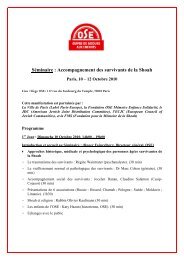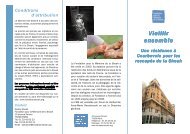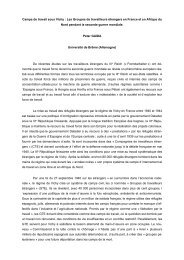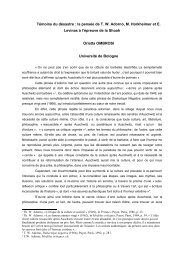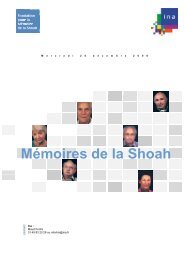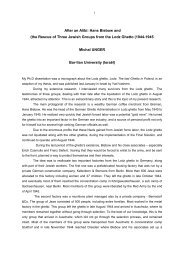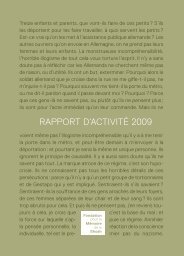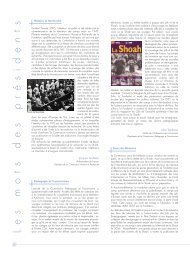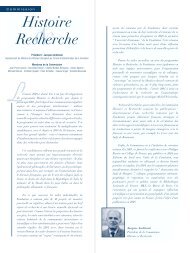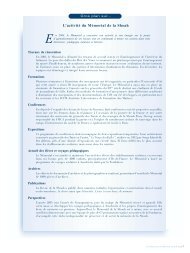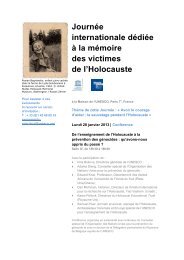Daniel Brewing, M.A. In the Shadow of Auschwitz In a recent article ...
Daniel Brewing, M.A. In the Shadow of Auschwitz In a recent article ...
Daniel Brewing, M.A. In the Shadow of Auschwitz In a recent article ...
You also want an ePaper? Increase the reach of your titles
YUMPU automatically turns print PDFs into web optimized ePapers that Google loves.
<strong>Daniel</strong> <strong>Brewing</strong>, M.A. <strong>In</strong> <strong>the</strong> <strong>Shadow</strong> <strong>of</strong> <strong>Auschwitz</strong><br />
transgression and attempts to regulate from above and <strong>the</strong> self-authorization <strong>of</strong><br />
agents defining what is permitted, prohibited and ordered in this area. This<br />
combination produced a constantly high level <strong>of</strong> violence that left behind destroyed<br />
landscapes and millions <strong>of</strong> dead.<br />
Preliminary findings and contributions<br />
My dissertation project is an innovative approach to <strong>the</strong> historical study <strong>of</strong> <strong>the</strong><br />
violent German occupation in Eastern Europe that will broaden, amend, and correct<br />
in many respects <strong>the</strong> scholarly understanding <strong>of</strong> German rule in Poland, and “<strong>the</strong><br />
East”. <strong>In</strong> my paper I would like to highlight just six relevant new vistas which my<br />
project discloses.<br />
(1) Violence against ethnic Poles developed within a broader framework <strong>of</strong> long-,<br />
middle- and short-term objectives which were set by <strong>the</strong> top level leadership. Over<br />
time, this framework generated both intentional and situational violence against <strong>the</strong><br />
civilian population. Within this framework, Nazi violence unfolded through <strong>the</strong><br />
entanglement <strong>of</strong> warfare, racial restructuring, economic, agrarian, and security<br />
policies.<br />
(2) The inherent conflicts and opposing interests within <strong>the</strong> different branches <strong>of</strong> <strong>the</strong><br />
occupation apparatus caused numerous contradictions, which in turn produced<br />
crucial variations in both <strong>the</strong> intensity and <strong>the</strong> focus <strong>of</strong> violence over time.<br />
(3) Violence against ethnic Poles was a product <strong>of</strong> transfers between different agents<br />
and institutions all over German occupied Eastern Europe. Know-how on specific<br />
forms and methods <strong>of</strong> violence was transmitted especially within <strong>the</strong> SS apparatus<br />
but also included <strong>the</strong> civilian administration and <strong>the</strong> German army. This exchange<br />
transcended <strong>the</strong> classic center/periphery pattern as within and beyond <strong>the</strong> SS<br />
apparatus traditional elements <strong>of</strong> hierarchical formalism lost <strong>the</strong>ir importance. <strong>In</strong> <strong>the</strong><br />
occupied Polish territories, <strong>the</strong> German personnel interacted vertically, horizontally<br />
and diagonally. This interaction created a dynamic, ever more borderless exchange <strong>of</strong><br />
violent methods and experts on violence.<br />
(4) Violence against ethnic Poles was, at least partially, a product <strong>of</strong> complex<br />
processes <strong>of</strong> interaction between <strong>the</strong> German occupiers and occupied Poles<br />
<strong>the</strong>mselves. A closer look at <strong>the</strong> local level reveals mechanisms <strong>of</strong> cooperation in field



